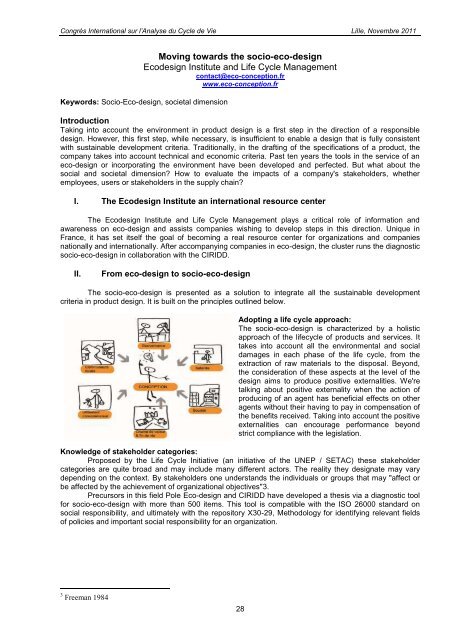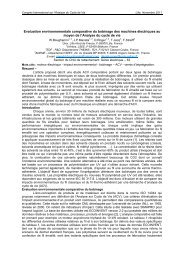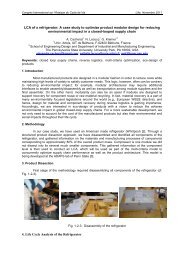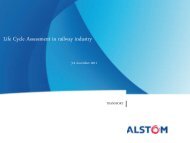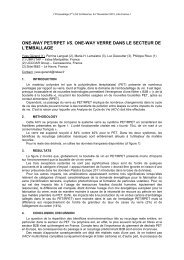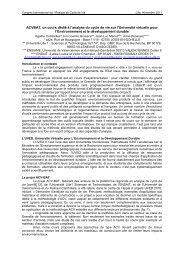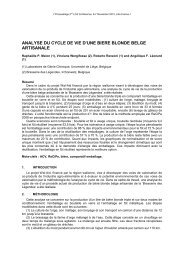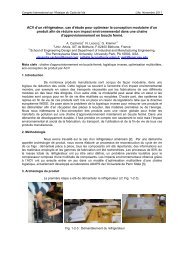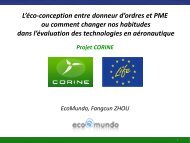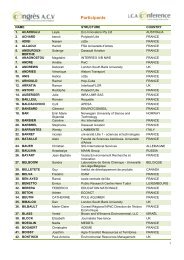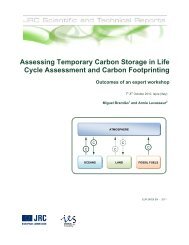Untitled - avniR
Untitled - avniR
Untitled - avniR
Create successful ePaper yourself
Turn your PDF publications into a flip-book with our unique Google optimized e-Paper software.
Congrès International sur l’Analyse du Cycle de Vie Lille, Novembre 2011<br />
Moving towards the socio-eco-design<br />
Ecodesign Institute and Life Cycle Management<br />
contact@eco-conception.fr<br />
www.eco-conception.fr<br />
Keywords: Socio-Eco-design, societal dimension<br />
Introduction<br />
Taking into account the environment in product design is a first step in the direction of a responsible<br />
design. However, this first step, while necessary, is insufficient to enable a design that is fully consistent<br />
with sustainable development criteria. Traditionally, in the drafting of the specifications of a product, the<br />
company takes into account technical and economic criteria. Past ten years the tools in the service of an<br />
eco-design or incorporating the environment have been developed and perfected. But what about the<br />
social and societal dimension? How to evaluate the impacts of a company's stakeholders, whether<br />
employees, users or stakeholders in the supply chain?<br />
I. The Ecodesign Institute an international resource center<br />
The Ecodesign Institute and Life Cycle Management plays a critical role of information and<br />
awareness on eco-design and assists companies wishing to develop steps in this direction. Unique in<br />
France, it has set itself the goal of becoming a real resource center for organizations and companies<br />
nationally and internationally. After accompanying companies in eco-design, the cluster runs the diagnostic<br />
socio-eco-design in collaboration with the CIRIDD.<br />
II.<br />
From eco-design to socio-eco-design<br />
The socio-eco-design is presented as a solution to integrate all the sustainable development<br />
criteria in product design. It is built on the principles outlined below.<br />
Adopting a life cycle approach:<br />
The socio-eco-design is characterized by a holistic<br />
approach of the lifecycle of products and services. It<br />
takes into account all the environmental and social<br />
damages in each phase of the life cycle, from the<br />
extraction of raw materials to the disposal. Beyond,<br />
the consideration of these aspects at the level of the<br />
design aims to produce positive externalities. We're<br />
talking about positive externality when the action of<br />
producing of an agent has beneficial effects on other<br />
agents without their having to pay in compensation of<br />
the benefits received. Taking into account the positive<br />
externalities can encourage performance beyond<br />
strict compliance with the legislation.<br />
Knowledge of stakeholder categories:<br />
Proposed by the Life Cycle Initiative (an initiative of the UNEP / SETAC) these stakeholder<br />
categories are quite broad and may include many different actors. The reality they designate may vary<br />
depending on the context. By stakeholders one understands the individuals or groups that may "affect or<br />
be affected by the achievement of organizational objectives"3.<br />
Precursors in this field Pole Eco-design and CIRIDD have developed a thesis via a diagnostic tool<br />
for socio-eco-design with more than 500 items. This tool is compatible with the ISO 26000 standard on<br />
social responsibility, and ultimately with the repository X30-29, Methodology for identifying relevant fields<br />
of policies and important social responsibility for an organization.<br />
3 Freeman 1984<br />
28


